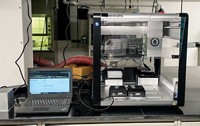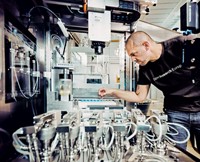Advertisement
Grab your lab coat. Let's get started
Welcome!
Welcome!
Create an account below to get 6 C&EN articles per month, receive newsletters and more - all free.
It seems this is your first time logging in online. Please enter the following information to continue.
As an ACS member you automatically get access to this site. All we need is few more details to create your reading experience.
Not you? Sign in with a different account.
Not you? Sign in with a different account.
ERROR 1
ERROR 1
ERROR 2
ERROR 2
ERROR 2
ERROR 2
ERROR 2
Password and Confirm password must match.
If you have an ACS member number, please enter it here so we can link this account to your membership. (optional)
ERROR 2
ACS values your privacy. By submitting your information, you are gaining access to C&EN and subscribing to our weekly newsletter. We use the information you provide to make your reading experience better, and we will never sell your data to third party members.
Computational Chemistry
Software directs automated synthesis
“Chemputer” could relieve humans from the busywork of routine syntheses
by Sam Lemonick
November 29, 2018
Automation is nothing new in chemistry. Robots can synthesize peptides, and they make high-throughput screening possible. A new setup takes this even further, combining software and hardware in an effort to take routine syntheses—from procedure to purification—out of chemists’ hands entirely.
Leroy Cronin and colleagues at the University of Glasgow have now demonstrated their so-called Chemputer’s ability to synthesize three drug molecules (Science 2018, DOI: 10.1126/science.aav2211). With some help from humans, it converted published experimental methods into computer code that guided robotic lab equipment through reaction, workup, and purification steps to create target chemicals.
“Anywhere you see a chemistry lab I think something like this could be extremely powerful,” says Alex Godfrey, who has spent his career working on automated chemistry. Godfrey wasn’t involved in the work but discussed the new paper with Cronin before its publication.

The Chemputer comprises several parts. There’s the physical equipment: bottled reagents, a round-bottom flask, filtration and liquid-liquid separation components, a rotary evaporator, and tubes, valves, and pumps to move chemicals through the system. Software also plays a key role. In published experiments, group members had to write synthesis instructions in a format the Chemputer can process. Cronin says he has since used natural-language software to complete a synthesis based on a procedure found in the Reaxys database without any human intervention. A software tool the group calls the Chempiler uses the synthesis instructions and a digital map of the hardware to conduct the synthesis. The researchers demonstrated syntheses of diphenhydramine hydrochloride, commonly sold as Benadryl; rufinamide, used as an anticonvulsant; and sildenafil, better known as Viagra.
Godfrey thinks the Chempiler is the real prize in Cronin’s paper. He says other automation software he has interacted with is made for very specific reactions and equipment. Chempiler can in principle handle any chemistry that can be done in a round-bottom flask if it has good directions and the right Chemputer hardware. Godfrey is also encouraged by Cronin’s efforts to remove any human input: “Information needs to be automatically fed into machines” for automation to become common in chemistry labs, he says.
The ultimate goal, Cronin says, is that organic chemists will never have to do routine syntheses and can focus entirely on coming up with new reactions. He says he intends to create an open-source database of synthesis procedures a Chemputer can understand, which chemists anywhere will be able to access and contribute to. Cronin also believes the Chemputer could make synthesis safer by keeping chemists out of the lab, and greener by helping researchers minimize solvent use.
Nicola L. B. Pohl of Indiana University Bloomington, who is working on her own automation software, says the key to success for the Chemputer will be making sure other chemists can easily learn and use Cronin’s software. Cronin has made his codes available. “I hope this work will have more synthetic chemists thinking about how to adapt their chemistry to automation,” Pohl says.





Join the conversation
Contact the reporter
Submit a Letter to the Editor for publication
Engage with us on Twitter